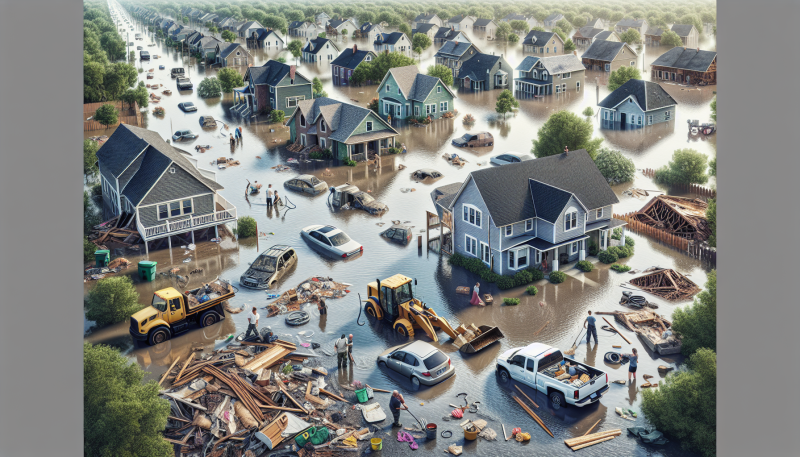Floods can be devastating, leaving behind a trail of destruction that affects both commercial and residential properties. The aftermath of a flood is often overwhelming, but knowing the essential recovery steps can make a significant difference in the restoration process. In this comprehensive guide, we will delve into the critical steps for flood damage recovery, ensuring you have the knowledge to restore your property efficiently and effectively. Whether you’re dealing with water damage, mold growth, or structural issues, this guide will provide you with the necessary insights to navigate the recovery process.
Understanding the Impact of Flood Damage
Flood damage can have far-reaching consequences, affecting various aspects of your property. From structural damage to mold growth, the impact of a flood can be extensive. It’s crucial to understand the different types of damage that can occur and how they can affect your property. This knowledge will help you prioritize the recovery steps and ensure that all aspects of the damage are addressed.
One of the most common issues resulting from flood damage is water damage. Water can seep into walls, floors, and ceilings, causing structural damage and weakening the integrity of your property. Additionally, standing water can lead to mold growth, which poses health risks and further damages your property. To effectively address these issues, it’s essential to engage in professional water damage restoration services.
Essential Recovery Steps
1. Safety First
Before you begin the recovery process, it’s crucial to ensure the safety of everyone involved. Floodwaters can contain hazardous materials, including sewage, chemicals, and debris. Wear protective gear, such as gloves, masks, and boots, to minimize exposure to these hazards. Additionally, turn off the electricity and gas supply to prevent accidents and further damage.
2. Assess the Damage
Once it’s safe to enter the property, conduct a thorough assessment of the damage. Document the extent of the damage with photographs and detailed notes. This documentation will be essential for insurance claims and will help restoration professionals develop an effective recovery plan. If you’re unsure about the extent of the damage, consider hiring a professional for a comprehensive mold assessment and damage evaluation.
3. Water Extraction and Drying
Removing standing water is a critical step in the recovery process. Use pumps, wet vacuums, and dehumidifiers to extract water and dry out the affected areas. It’s essential to act quickly to prevent further damage and mold growth. Professional dehumidification services can ensure that all moisture is effectively removed, reducing the risk of mold and structural damage.
4. Mold Remediation
Mold can begin to grow within 24-48 hours of a flood, making it crucial to address this issue promptly. Mold remediation involves identifying and removing mold growth, as well as addressing the underlying moisture problem. Professional mold assessment and remediation services can ensure that all mold is effectively removed, preventing further health risks and property damage.
5. Structural Repairs
Floods can cause significant structural damage, including weakened foundations, damaged walls, and compromised flooring. It’s essential to address these issues to ensure the safety and stability of your property. Engage in professional reconstruction services to repair and restore the structural integrity of your property.
6. Content Cleaning and Restoration
Floods can damage personal belongings, furniture, and other contents of your property. Professional content cleaning and restoration services can help salvage and restore these items. This process involves cleaning, disinfecting, and drying affected items to prevent further damage and ensure they are safe to use.
7. Biohazard Cleanup
Floodwaters can contain hazardous materials, including sewage and chemicals. It’s essential to engage in professional biohazard cleanup services to safely remove and dispose of these materials. This process ensures that your property is safe and free from harmful contaminants.
8. Insurance Claims Assistance
Filing an insurance claim can be a complex and time-consuming process. Professional restoration companies often offer insurance claims assistance to help you navigate this process. They can provide the necessary documentation and work with your insurance company to ensure you receive the compensation you deserve.
9. 24/7 Emergency Services
Flood damage can occur at any time, and it’s essential to have access to 24/7 emergency services. Professional restoration companies, like Projekt Restoration, offer round-the-clock services to address flood damage promptly and effectively. This immediate response can significantly reduce the extent of the damage and expedite the recovery process.
Conclusion
Flood damage can be overwhelming, but knowing the essential recovery steps can make a significant difference in the restoration process. From ensuring safety to engaging in professional restoration services, each step plays a crucial role in restoring your property. Projekt Restoration is your go-to water, fire, & mold restoration experts. We also offer mold assessment, biohazard cleanup, and reconstruction services. Don’t let flood damage disrupt your life—take the necessary steps to restore your property and get back to normalcy. For professional assistance and comprehensive restoration services, contact Projekt Restoration today.





